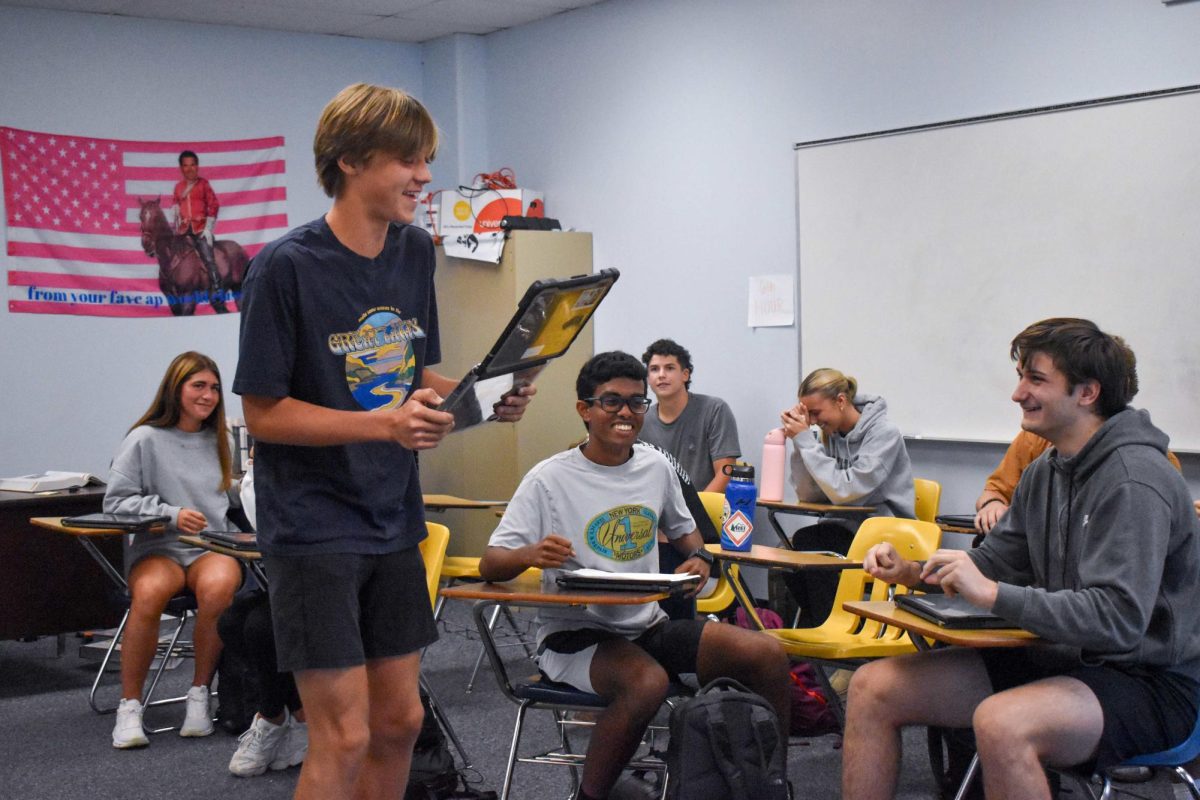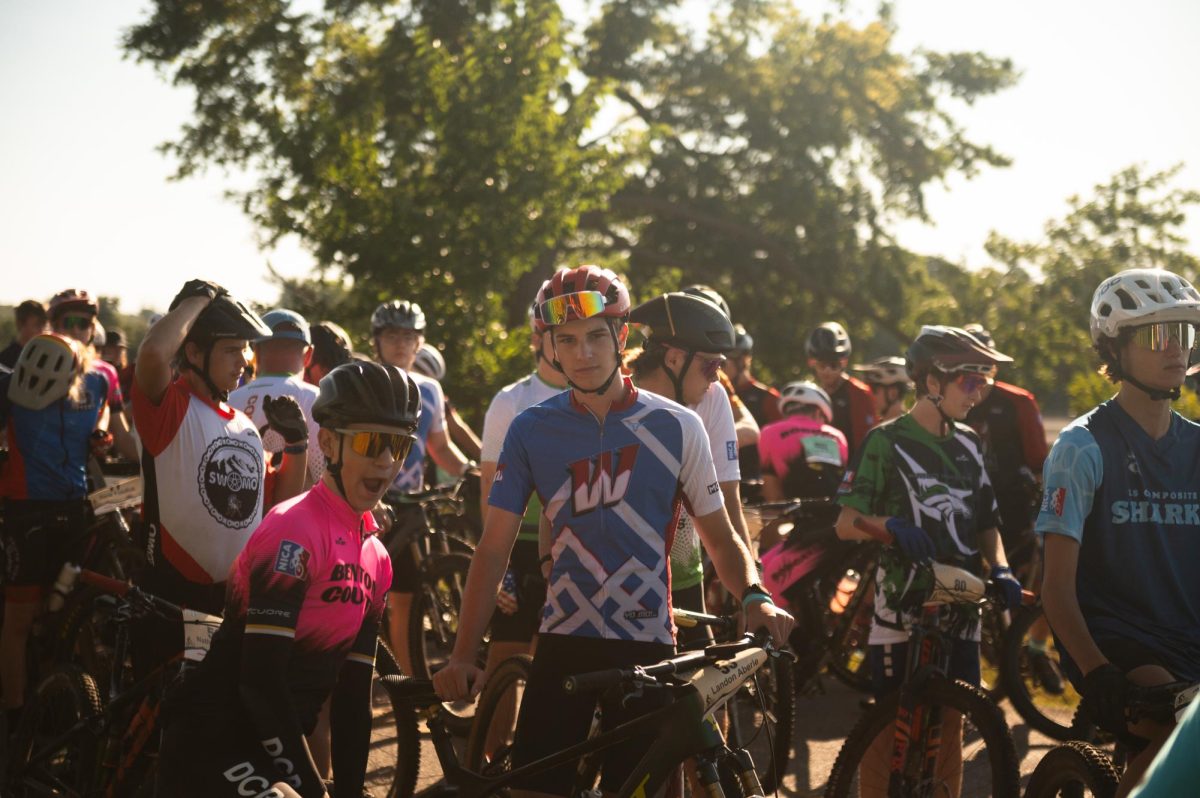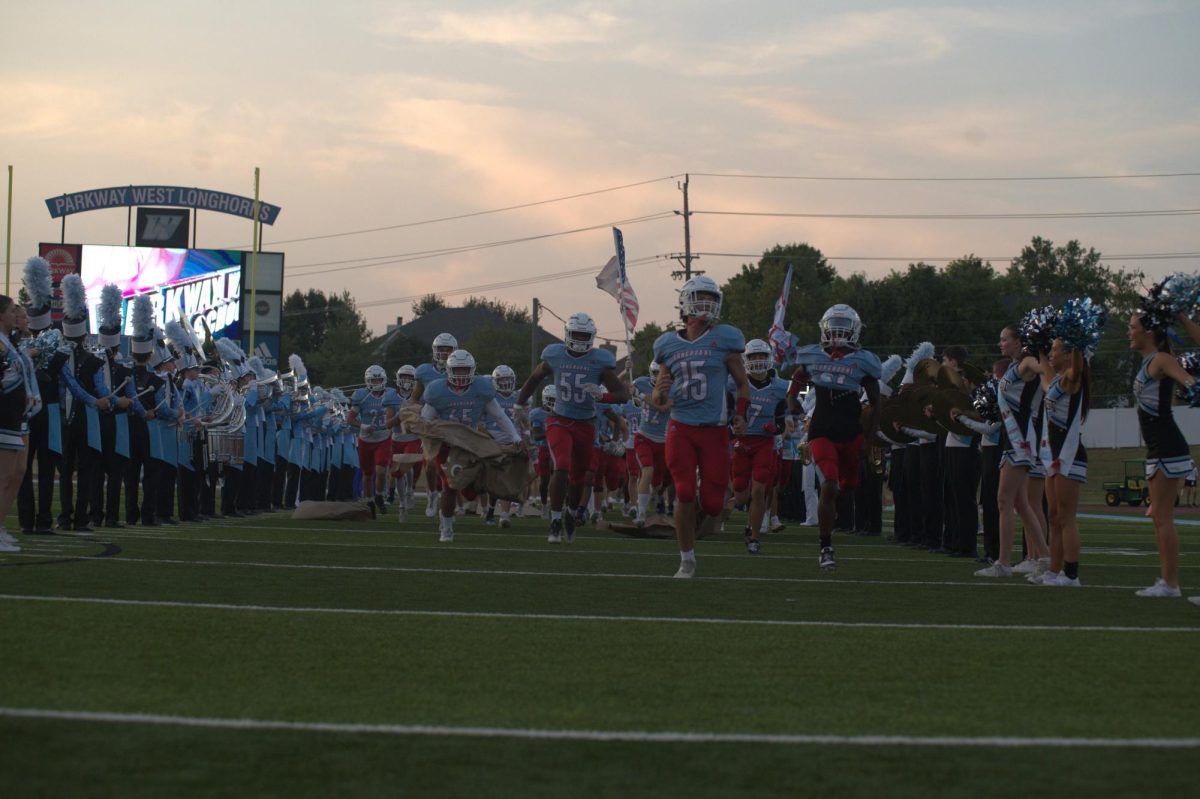Eating disorders are commonly associated with body dysmorphia issues; however, for sophomore Lila Hartle, that was not the case. What started as a small loss of appetite quickly escalated. Her eating disorder became increasingly prevalent as her hunger cues were cut off. Then, she stopped feeling hungry entirely.
In July 2021, Hartle realized something was wrong with her health as she began to experience fatigue, a loss of appetite and dizziness.
“The year leading up to getting treatment, I knew something was off,” Hartle said. “My parents were in disbelief because it didn’t make any sense. I still had cravings for junk food, and fast food, which made it really confusing. [According to] what we’re taught about eating disorders, my eating disorder did not line up with [my parents’] traditional lines.”
Looking past the small signs, what pushed Hartle to suspect she had an eating disorder was a summer intensive for dance. Hartle has been dancing since she was three and considers it a huge part of her life. Hartle got 15 minutes into a routine during a dance intensive before fainting.
“When you’re malnourished, your body takes a step back and starts eating at your muscles, so it goes into a constant state of fight or flight. [When I found out I couldn’t dance], I was devastated, but I knew recovery was the only way I could continue dance in a healthy way and [pursue] it as a career,” Hartle said.
Contrary to most anorexia diagnoses, Hartle didn’t excessively exercise, diet or outwardly display an unhealthy relationship with her body. Because of the unusuality of her symptoms, her condition was completely new to the professionals she was in contact with, making the recovery process more challenging. Since she didn’t deal with body dysmorphia or experience a drastic weight change, she struggled to receive a diagnosis.
“[Eating disorders] almost always have something to do with body image, but the only thing I’ve had problems with were my wrists,” Hartle said. “I don’t completely agree with my diagnosis because anorexia, in my mind, has to do with body image, and I’ve never really struggled with body image.”
After being diagnosed, Hartle began to eat lunch with her mother in her car instead of in the cafeteria. Hartle started treatment in November 2021 when her therapist recommended her to an outpatient program at the St. Louis Behavioral Medicine Institute. She attended five days a week for three hours a day to eat dinner with other girls in the program.
“[The program] helped a lot with eating more. It was much easier to eat in a room with five other girls struggling to finish their meals. Unity was very quickly formed among the group. It gave me the sense that I’m not in this alone, [and] other girls are going through this with me,” Hartle said. ”We used to have drawing competitions after every meal, and we’d hang them all up on the fridge after. One of the girls even brought her crocheting supplies and taught all of us to crochet. These little moments created a sense of [unity] amongst the girls. It let us know that [anorexia] happens to many girls, no matter how it presents itself.”
After four weeks in the program, Hartle was scheduled to be discharged until she got Influenza. The weight she lost due to being sick undid her progress. Maintaining a steady weight was one of the criteria for leaving the program, so being sick caused her to start from scratch.
“It was degrading because [until] that point, I was feeling really good about myself. [Getting sick] was the lowest point in the whole experience [because] it set all of my progress back,” Hartle said. “I was pissed, to say the least. I was with all new girls. It was demeaning in a way. The girls [I started with] weren’t in the program anymore, and I was, and while they may not have fully recovered, they were able to have more freedom.”
Despite the difficulty of restarting, Hartle saw it as a place to build up from. While the program limited the amount of exercise she could get, Hartle was able to start going on walks around late January 2022.
“Being allowed to go on walks instead of completely resting my body meant I could get serotonin. Around that time, I also started journaling, and I talked to my therapist about what I needed, what I was struggling with and how to work through it. Being able to talk to someone and write things down got my thoughts out of my head and gave me an outlet,” Hartle said.
With a determined mindset and encouragement from family and friends, Hartle recovered in February 2022 and was discharged from the program.
“Even though I didn’t struggle with body image, the program helped me [differently]. I was able to find a place where we all [thought], ‘I finished my meal today, and that’s a great thing,’” Hartle said. “The first day I was back in the cafeteria, I sat down with my friend group, and I remember everyone being so excited. It was a really supportive environment. Everyone was there for me, and they were all like, ‘you finally got this.’”
Through the program, Hartle gained a viewpoint on how hard recovery can be for girls, and has some words of advice for them.
“It’s important to be ready to recover, because if you’re not it will make the process a million times harder than it is, and even though recovery seems really hard just focus on little steps at a time. Even if you lose a large amount of progress it’s quicker to regain it because you’ve done it before and you’re prepared to take on the challenge. Just focus on getting back to what you love, that was one of the strongest things that kept me going,” Hartle said.
Harmful stigmas and stereotypes can be amplified across social media and can make it harder for those like Hartle to access help.
“[These] stereotypes aren’t the way eating disorders are,“ Hartle said. “All of the stigmas around eating disorders just makes it harder for girls to reach out and get help, and that was especially hard for me to do once I was in treatment because my disorder didn’t fit the textbook eating disorder.”
While there are various stereotypes in online spaces, Hartle found a supportive place on social media that promoted eating over diet culture and encouraged her to keep going until she reached recovery.
“Some of the girls I was [in the program] with were really affected by social media, and it screwed them over and made everything worse,” Hartle said. “[However], I found a place on social media where instead of being like ‘you have to be skinny,’ I was able to find people supporting each other and being like ‘I know it’s a rough time, but you can and will get out of this.’”
While Hartle is recovered today, she still occasionally struggles with remembering to eat, but rather than not eating like before, she does her best to make sure that she finishes her meals.
“I’m better than I am before, but there are definitely still hard days where I just don’t feel hungry and don’t want to eat. Despite that, I still eat every meal, and even if I feel really nauseous afterward I just lay down, breathe and push through it until I’m all good. If pre-recovery me looked at how far I’ve come today, I think she would be really proud,” Hartle said.





![Freshman Daphne Stokes looks at a table with Veterans Day flyers and information on Nov. 11. Stokes, along with other West High students, like senior Alexander Lewinski, passed by the table in the cafeteria with army recruitment information and giveaways for students to observe during lunch. “Talking with [the recruiters] has definitely helped me [find] where I wanted to go, more than anything else,” Lewinski said.](https://pwestpathfinder.com/wp-content/uploads/2025/11/DSC_1227-2-1200x800.jpg)
![Helping a customer, print room assistant Gretchen Williams operates her booth at the West High Craft Fair from Oct. 25-26. This was Williams’ first time participating in the Craft Fair with her new craft shop, Gs Beaded Boutique. “People have always said, over the years, ‘you should open something.’ [I replied that] I would rather just make [my crafts as] gifts for people. I just started [the online store] up, and it's been okay. I'm always surprised [by] how many views I get and [the] people from different states buying things; somebody from Alaska bought something the other day.”](https://pwestpathfinder.com/wp-content/uploads/2025/11/DSC0451-2-1200x799.jpg)
![Gesturing toward the club’s name on the board, Global Youth Aid co-president year Daniah Alsagheer discusses upcoming service projects with members during a meeting on Oct. 30. “We might be one club at one school, but together, we’re [part of] something much bigger,” Alsagheer said.](https://pwestpathfinder.com/wp-content/uploads/2025/11/DSC00949-1200x800.jpg)
![Focused on providing exceptional service, sophomore Darsh Mahapatra carefully cleans the door of a customer’s car. Mahapatra has always believed his customers deserve nothing less than the best. “[If] they’re trusting us with their car and our service, then I am convinced that they deserve our 100 percent effort and beyond,” Mahapatra said.](https://pwestpathfinder.com/wp-content/uploads/2025/10/DSC_0018-1200x800.jpg)
![Sophomore Aleix Pi de Cabanyes Navarro (left) finishes up a soccer game while junior Ava Muench (right) warms up for cross country practice. The two came to Parkway West High School as exchange students for the 2025-2026 school year. “The goal for the [exchange] program is to provide opportunities for both Parkway students and our international exchange students to learn about other cultures, build connections and become confident, capable, curious and caring — Parkway’s Four C’s — in the process,” Exchange Program Lead Lauren Farrelly said.](https://pwestpathfinder.com/wp-content/uploads/2025/10/Feature-Photo-1200x800.png)

![Gazing across the stage, sophomore Alexis Monteleone performs in the school theater. The Monteleone family’s band “Monte and the Machine” has been releasing music since 2012, but Alexis started her own solo career in 2024 with the release of her first single, Crying Skies. “My whole family is very musical, [and I especially] love writing [songs with them],” Monteleone said.](https://pwestpathfinder.com/wp-content/uploads/2025/09/DSC7463-1200x798.jpg)
![Amid teaching a lesson to her AP Calculus BC class, Kristin Judd jokes alongside her students in their funny remarks. Judd has always enjoyed keeping the mood light in her classroom, along with on the volleyball court. “[I enjoy] that side talk where you see [or] overhear a conversation and chime in, or somebody says something funny,” Judd said.](https://pwestpathfinder.com/wp-content/uploads/2025/09/image-1200x730.jpg)
![Eyeing the ball, junior Ella McNeal poses for her commitment pictures at Clemson University. McNeal’s commitment comes after months of contact with top Division 1 soccer programs. “ It has taken a lot to get to where I am, but I know that [what] I've already been through is just the beginning, and I can't wait for what is to come,” McNeal said.](https://pwestpathfinder.com/wp-content/uploads/2025/09/IMG_4926-1200x900.jpeg)

![Sophomore Shree Sikkal Kumar serves the ball across the court in a match against Lindbergh. Sikkal Kumar has been a varsity member of the varsity girls’ tennis team for two years, helping her earn the number two rank in Class 2 District 2.“When matches are close, it’s easy to get nervous, but I [ground] myself by[staying] confident and ready to play,” Sikkal Kumar said.](https://pwestpathfinder.com/wp-content/uploads/2025/11/DSC2801-1200x798.jpg)
![Dressed up as the varsity girls’ tennis coach Katelyn Arenos, senior Kate Johnson and junior Mireya David hand out candy at West High’s annual trunk or treat event. This year, the trunk or treat was moved inside as a result of adverse weather. “As a senior, I care less about Halloween now. Teachers will bring their kids and families [to West’s Trunk or Treat], but there were fewer [this year] because they just thought it was canceled [due to the] rain. [With] Halloween, I think you care less the older you get,” Johnson said.](https://pwestpathfinder.com/wp-content/uploads/2025/10/DSC00892-1-1200x800.jpg)
![Leaning on the podium, superintendent Melissa Schneider speaks to Parkway journalism students during a press conference. Schneider joined Parkway in July after working in the Thompson School District in Colorado. “My plan [to bond with students] is to get things on my calendar as much as possible. For example, being in [classes] is very special to me. I am trying to be opportunistic [meeting] kids [and] being in [the school] buildings. I have all the sports schedules and the fine arts schedules on my calendar, so that when I'm available, I can get to them,” Schneider said.](https://pwestpathfinder.com/wp-content/uploads/2025/09/IMG_5425-1200x943.jpeg)

![Leaping through the air, senior Tyler Watts celebrates his first goal of the season, which put the Longhorns up 1-0 against the Lafayette Lancers. Watts decided to play soccer for West for his last year of high school and secured a spot on the varsity roster. “[Playing soccer for West] is something I had always dreamed of, but hadn’t really had a good opportunity to do until now. It’s [really] fun being out [on the field], and I’m glad I decided to join the team. It’s just all about having fun with the boys and enjoying what time we have left together,” Watts said.](https://pwestpathfinder.com/wp-content/uploads/2025/09/DSC_1951-1200x855.jpg)

![Shifting global trade, President Donald Trump’s tariffs are raising concerns about economic stability for the U.S. and other countries alike. “[The tariffs are] going to pose a distinct challenge to the U.S. economy and a challenge to the global economy on the whole because it's going to greatly upset who trades with who and where resources and products are going to come from,” social studies teacher Melvin Trotier said.](https://pwestpathfinder.com/wp-content/uploads/2025/05/MDB_3456-1200x800.jpg)

![Pitching the ball on Apr. 14, senior Henry Wild and his team play against Belleville East. Wild was named scholar athlete of the year by St. Louis Post-Dispatch after maintaining a high cumulative GPA and staying involved with athletics for all of high school. “It’s an amazing honor. I feel very blessed to have the opportunity to represent my school [and] what [it] stands for,” Wild said.](https://pwestpathfinder.com/wp-content/uploads/2025/05/unnamed-6-1200x714.jpg)

kristen • Jan 12, 2023 at 10:45 am
Amazing!!!!!
Serena • Jan 11, 2023 at 11:57 am
This is such a beautiful story Nidhi